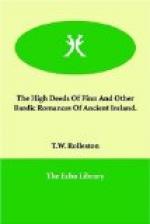It is owing to the careful, accurate, and critical work of continental and Irish scholars on the manuscript materials of Irish Law, History, Bardic Tales, and Poetry; on customs, dress, furniture, architecture, ornament, on hunting and sailing; on the manners of men and women in war and peace, that the modern re-teller of the Irish tales is enabled to conserve the Irish atmosphere. And this conservation of the special Irish atmosphere is the second result which the work of the critical scholars has established. If the re-writer of the tales does not use the immense materials made ready to his hand for illustration, expansion, ornament and description in such a way that Ireland, and only Ireland, lives in his work from line to line, he is greatly to be blamed.
Mr Rolleston has fulfilled these conditions with the skill and the feeling of an artist. He has clung closely to his originals with an affectionate regard for their ancientry, their ardour and their distinction, and yet has, within this limit, used and modified them with a pleasant freedom. His love of Ireland has instilled into his representation of these tales a passion akin to that which gave them birth. We feel, as we read, how deep his sympathy has been with their intensity, their love of wild nature, their desire for beauty, their interest in humanity and in character, their savagery and their tenderness, their fairy magic and strange imaginations that suddenly surprise and charm. Whenever anything lovely emerges in the tale, he does not draw attention to it, but touches it with so artistic a pencil that its loveliness is enhanced. And he has put into English verse the Irish poems scattered through the tales with the skill and the temper of a poet. I hope his book will win what it deserves—the glad appreciation of old and young in England, and the gratitude of Ireland.
The stories told in this book belong to three distinct cycles of Irish story-telling. The first are mythological, and are concerned with the early races that are fabled to have dwelt and fought in Ireland Among these the Tuatha De Danaan were the final conquerors, and held the land for two hundred years They were, it is supposed, of the Celtic stock, but they were not the ancestors of the present Irish. These were the Milesians (Irish, Scots or Gaelic who, conquering the Tuatha De Danaan, ruled Ireland till they were overcome by the English.) The stories which have to do with the Tuatha De Danaan are mythical and of a great antiquity concerning men and women, the wisest and the best of whom became gods, and who appear as divine beings in the cycle of tales which follow after them They were always at war with a fierce and savage people called Fomorians, whom they finally defeated and the strife between them may mythically represent the ancient war between the good and evil principles in the world.




